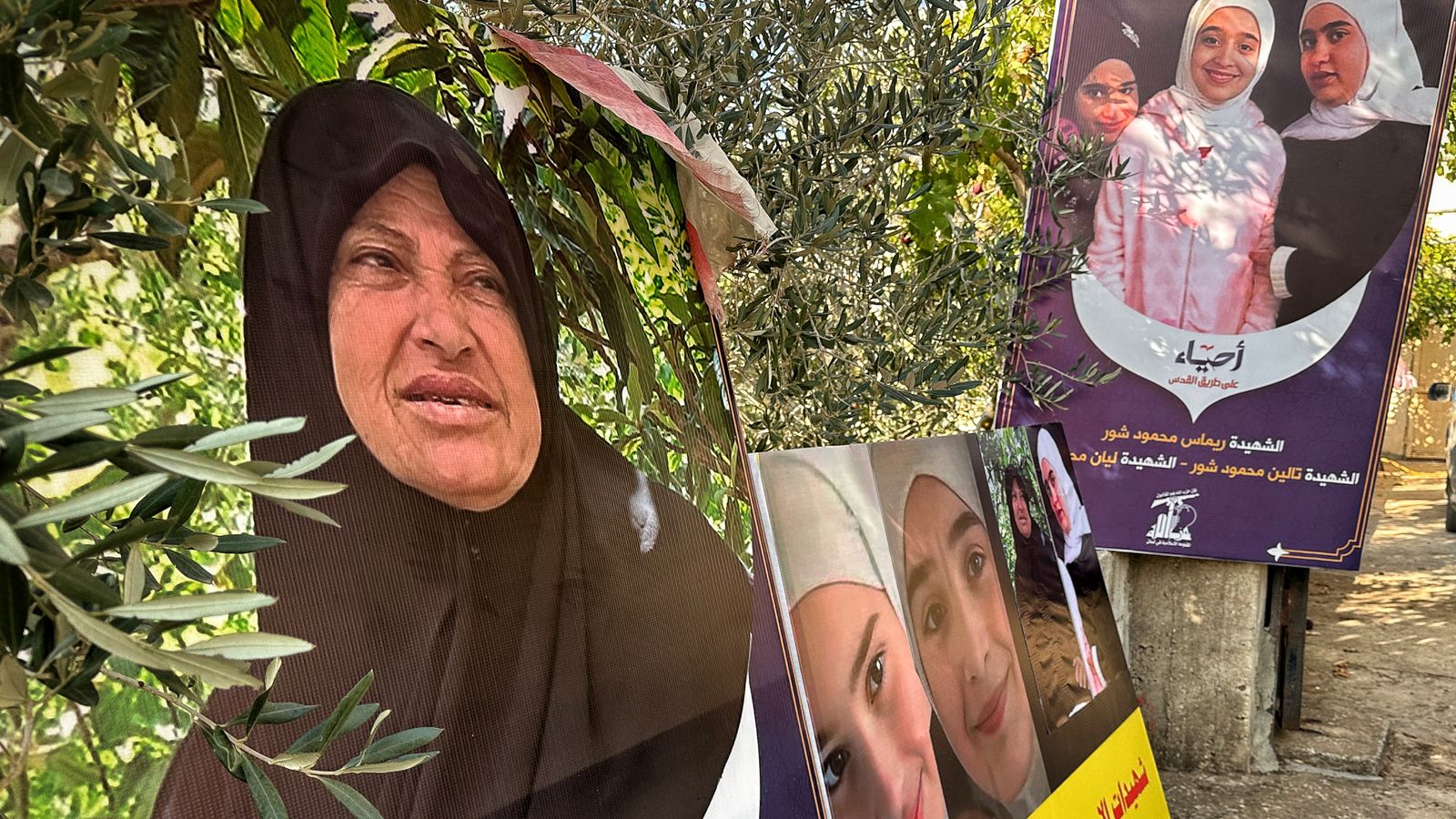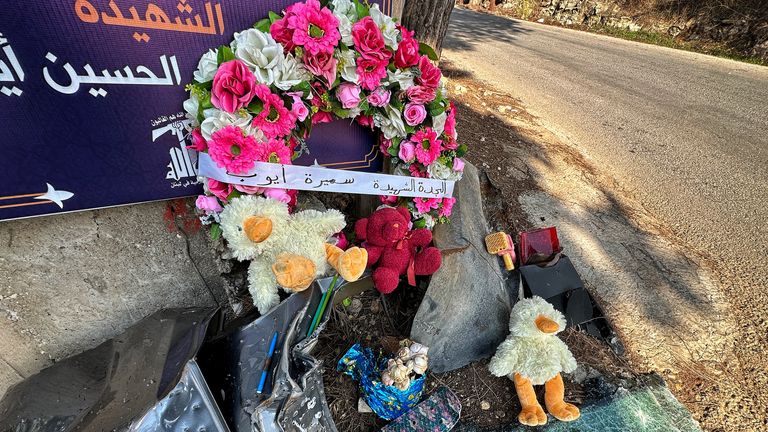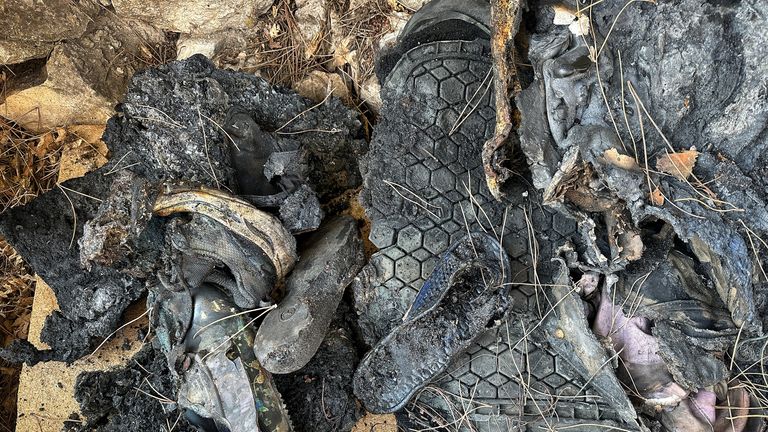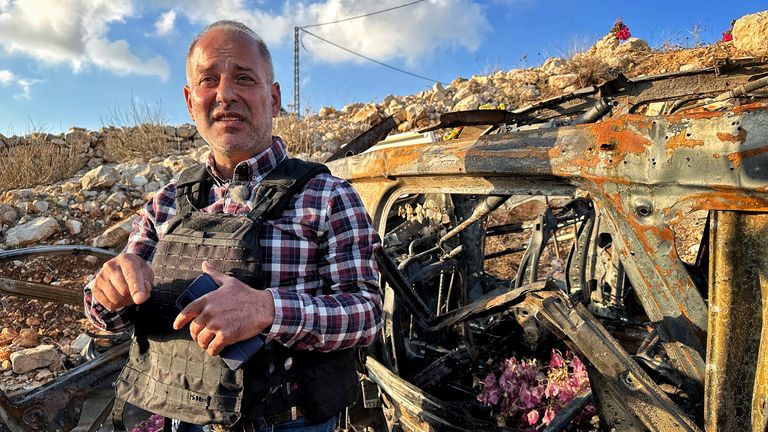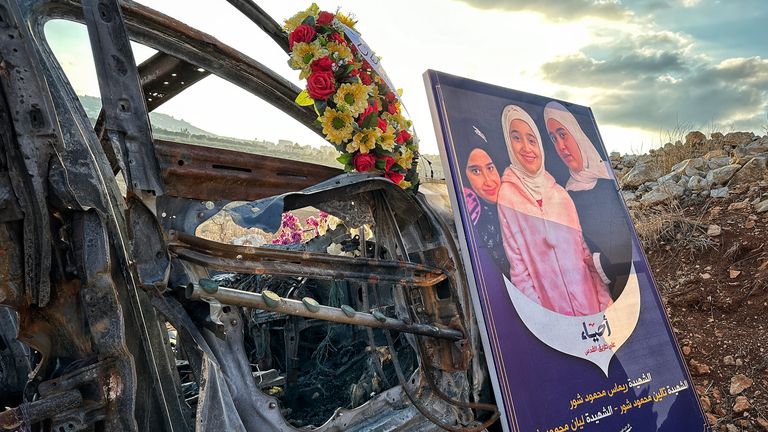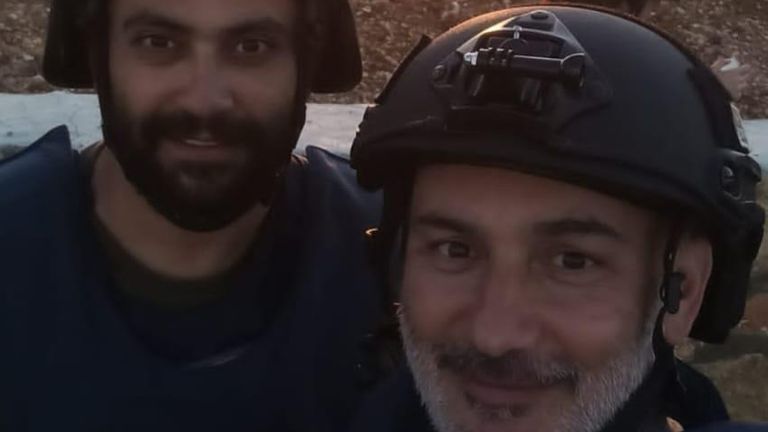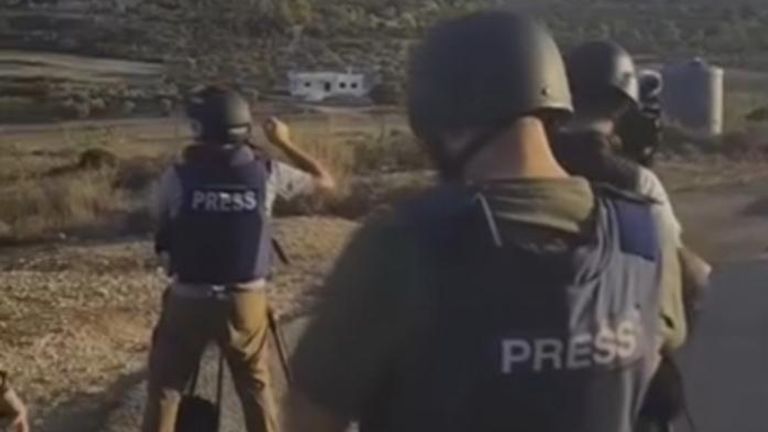There’s a makeshift shrine like none other outside the Ayoub family home in southern Lebanon.
Underneath a large picture of three little girls and their grandmother is a bright pink and white wreath of flowers.
But there are also black charred children’s shoes, a singed pencil case and blackened schoolbooks, with the edges of each page burnt.
There’s a section of what could be part of a car bonnet speckled with shrapnel holes sitting amongst two fluffy toy ducks and a pink teddy bear.
This is all that remains of an Israeli strike on the car carrying the three sisters, their mother and grandmother.
The family’s uncle Samir Ayoub is kneeling down in front of the shrine gathering up the scraps of burned school paper.
“I’m keeping them because there may be DNA on them, or blood or something that the international courts can use to prosecute the people who did this,” he says.
Latest updates: Premature babies ‘fighting serious conditions’ make it out of Gaza
He’s not the only one determined to get justice for what happened to his family. Human rights investigators are also gathering evidence to press for an independent criminal investigation into what they say is a war crime which took place on 5 November in Aynata in southern Lebanon.
“We found no evidence of any military target nearby,” says Ramzi Kaiss, from Human Rights Watch (HRW) in Lebanon.
He adds: “We have found this strike is unlawful because it violates the obligation that all parties should have to protect non-combatants.”
The Israel Defence Forces (IDF), known as the Israeli Occupying Force (IOF) in Lebanon, released drone footage on social media early on 6 November, the day after the strike.
The series of videos and stills of strikes that they posted appeared to indicate the attacks were in Gaza. There is no mention of Lebanon at all.
Among the grouping of hits, there was one video of an attack on a lone car moving along a road.
The Israeli military said at the time they had also hit a man called Jamal Musa who they say was responsible for the special security operations within Hamas.
It was not clear which strike they were referring to in the group of attacks they posted collectively on social media.
The Sky News Data and Forensics team managed to geolocate the footage to Lebanon – and the same road from Yarin to Aynata on which the family car containing the five women and girls had travelled.
Following our repeated requests for information and after multiple exchanges, the IDF then told us that it had hit what it called a “suspicious vehicle” with “several terrorists” inside but it is now investigating whether some ‘uninvolved civilians’ were also in the vehicle.
It did not give us any details about who the “several terrorists” might have been.
Ramzi Kaiss, from Human Rights Watch, says the admission by the IDF that it had carried out the strike indicated a “disrespect” for international humanitarian law.
The organisation insists that under humanitarian law, if there is any doubt, no attack should have been carried out and there needs to be evidence the target presents imminent danger.
HRW is now calling for international intervention and pressure to ensure humanitarian law is upheld.
“Israel on several occasions,” Kaiss says, “has failed to conduct credible investigations and hold individuals accountable for war crimes or other violations so Israel’s allies UK and US and others should press for accountability on this apparent war crime”.
The family of women and girls had decided they needed to finally leave their home on the southern border with Israel after weeks of slowly escalating attacks between Israel and the Iran-backed Lebanese group, Hezbollah.
Many of their neighbours had already left the area for safer regions away from the border.
The family’s tragic journey
The Sky News team went on the same journey the family took with Samir Ayoub, their uncle and a journalist and political analyst from the Russian broadcaster RT.
He’s lived in Russia for 33 years but had returned to southern Lebanon to help his sister Samira relocate with her three grandchildren; 14-year-old Rames, Talin, aged 12 and 10-year-old Lee-Anne, as well as her daughter-in-law, the girls’ mother, Houda.
Samir was escorting them in a separate car from their home in Yareen. He told us on the way to meet them, he was held up because of constant bombings along the route.
When he met up with them, the family, travelling in two cars now, chose to stop at a corner shop in the village of Aynata to pick up some water and snacks before their journey to Beirut.
CCTV outside the shop shows them entering the shop and then Houda, the mother, and 10-year-old Lee-Anne leaving and loading water bottles into the back.
Samir can be seen emerging on the right-hand side of the CCTV picture to help them.
As the car pulls away, you can just about catch sight of a woman wearing a black hijab in the passenger front seat (which Samir says was where grandmother Samira was sitting while Houda was at the steering wheel) and little figures in the rear of the car seat showing the three little girls sitting behind them.
He says he drove off first, in his car and had them in his rear-view mirror for the next 1.7km (one mile). He had already turned the corner of the road when he heard a huge blast.
He stopped and went back and when he looked round the corner the car had been blown off the road and into the nearby field and was already burning.
He ran down and says he saw the girls in the back who appeared already dead along with his sister, their grandmother Samira.
Their mother Houda was half out of the car and Samir pulled her to safety. “I could see the children melting in the flames and all I wanted to do was try to stop their mother from seeing her own children burning,” he told us as we stood next to the incinerated vehicle wreck.
“She didn’t say help me, or rescue me,” he said. “She just said I want my kids, where are my kids, help me get them out of the car.”
Even as we spoke, an Israeli drone circled above us the entire time. Samir pointed upwards and told us: “They were watching us on the day of the attack.”
He adds: “I even told the girls to play around outside of the car before we set off so the drone would see the vehicle was only carrying children.”
Vehicle became an inferno
Pictures filmed by eyewitnesses show that after the strike, the car turned into an inferno.
One of the shopkeepers who’d seen the family before the attack says they’d seemed excited. When they heard the explosion, one of them raced to the scene because he recognised the location was in the vicinity of his own home.
Hassan Kawsan said the vehicle was already on fire when he arrived. He described how tried to put the flames out but the extinguisher wasn’t working properly.
By the time he returned with a functioning one, the vehicle was engulfed in flames.
That night, local television filmed Samir with his shirt still covered in blood after pulling Houda out of the vehicle.
He was shouting at the cameras, addressing the Israeli military: “Are these children terrorists?” he demanded to know.
He wants the International Criminal Court to investigate and is urging European countries to help to ensure someone is held accountable for what happened to his family.
The death of a Reuters reporter
Meanwhile, Reporters Without Borders (RSF) has conducted an investigation into the death of Reuters journalist Issam Abdallah who was killed on 13 October, a few weeks before the girls and their grandmother – this time in Alma Shaab, Lebanon.
The group concluded the “targeted strike” came from the Israeli direction. “According to the ballistic analysis carried out by RSF, the shots came from the east of where the journalists were standing; from the direction of the Israeli border,” RSF said.
Jodie Ginsberg, from the Committee to Protect Journalists (CPJ), told Sky News: “We want to see an independent investigation into the killing of Reuters journalist Issam Abdallah in an attack which also severely injured several other journalists.
“A report by CPJ in May this year showed a decades-long pattern in which – prior to this latest war – at least 20 journalists have been killed by members of the Israel Defence Forces over the past 22 years and where no-one has ever been charged or held responsible for those deaths.
Journalists are civilians, not targets and those responsible for their killings must be held accountable.”
Referring to the incident in which Issam Abdallah was killed, an IDF statement said on the afternoon of 13 October, Hezbollah militants had launched attacks at several positions along the blue line, firing an anti-tank missile that struck the security fence of Israel near the community of Hanita.
The IDF said: “Immediately following the anti-tank missile launch, IDF soldiers suspected a terrorist infiltration into Israeli territory and, in response, used tank and artillery fire to prevent the infiltration.
“A report was received that during the incident, journalists were injured in the area. The incident is under review.”
Reporter’s friend speaks about incident for first time
We’ve spoken to one of Issam Abdallah’s close friends who was also working alongside him on the day.
Elie Brakhya, who is speaking about the incident publicly for the first time, is a veteran cameraman of numerous wars, including Ukraine, Syria, Yemen as well as Lebanon.
He tells us from his home in Beirut how the group of seven journalists had gone to the hilltop position in Alma Shaab on 13 October. The Israeli military and the Lebanese militia group Hezbollah have been trading fire across the border between the two countries since 7 October.
The group of journalists had gone to record the exchange of fire and were from a range of media outlets including Associated Press, AFP, Reuters and Al Jazeera, Elie’s employers. They were all clearly identifiable as media and were all wearing flak jackets and helmets marked with Press badges.
One of the vehicles parked right next to the group had press markings too. They positioned themselves where they could clearly be seen on the hilltop. “People could see us for miles around,” Elie says.
He says drones had been circulating for most of the time they were there as well as Israeli Apache helicopters. Several of the group had done live broadcasts from the position and they’d been there for more than an hour.
Issam had posted on his social media account, wearing his press-marked body armour. Elie took a selfie of the two friends together, again wearing their press-marked body armour.
“It was the last picture of the two of us,” he says. The group of journalists, he says, was relaxed and just going about their work when the strike hit.
“There was no whistle of anything coming from behind us,” Elie says. “We are experienced but not experts but it felt like it came from in front and above us.
“I saw straight away Issam was dead,” he adds. “He took the direct hit.”
Several of the journalists were badly injured and the friends raced around trying to help each other. Live streams of several cameras recorded the blast and the immediate reaction.
One, a young journalist from AFP, can be heard on camera shouting she couldn’t feel her legs. They feared a quick second strike, so time was precious. “There’s always a second strike,” Elie says. He ran to his vehicle to try to locate some tourniquets to help his colleagues when the second strike happened just in front of his vehicle.
The whole of his left side was hit by the blast and he feared he’d lost his shoulder entirely.
“When I looked I couldn’t see my shoulder,” he says. The helmet he was wearing was blown off entirely and his left ear was rendered deaf immediately.
On his right hand, his thumb was blown off and he remembers gathering it up and holding it to his body.
His legs had been showered with dozens of shrapnel and he couldn’t move. He realised he was under his car which was already burning. “Then someone pulled me out from under the vehicle and I just saw it burst into flames,” he tells us.
Read more:
Lebanese village caught in crossfire ‘could turn into battlefield’
At Hezbollah’s Martyrs’ Day commemoration, their leader threatens escalation
Lebanon on verge of war with Israel
When Elie’s friends later visited him in hospital, they apologised to him because he was so covered in blood they didn’t recognise him at the time and thought they were pulling a corpse from under the vehicle.
He checked the timecodes on his camera later and found there were 37 seconds between the two strikes.
“We were targeted, for certain,” he says. “There’s no chance we weren’t. Everyone could see us with our row of five tripods for miles.”
Lebanon blames Israel for double attack
The Lebanese military, which carried out an investigation into the incident, the Lebanese Prime Minister Najib Mikati and Reporters Without Borders agree with him and blame the Israelis for the double attack.
“We’re not kids. We are professionals. We know what we are doing and what to do and where to go. This is our job,” Elie says.
“We know there are dangers. Of course, there’s a price you have to pay… we are paying our share but there’s a responsibility about this and there are international laws which should protect us.”
Astonishingly he says this was the second attack within a few weeks that he and his team have come under in Lebanon. Nobody was hurt in the first instance.
In a third attack on journalists (which he was not involved in), again the cameras were rolling live while a group of journalists in Yaroun on the southern border with Israel broadcast.
Again, it was a double hit with seconds to spare. Despite vehicles being set alight, remarkably only one of the group was injured.
The Lebanese authorities have said they intend to file a complaint with the UN Security Council over what they call Issam’s “deliberate killing” by Israel.
Lebanon’s National News Agency says the foreign ministry has instructed Lebanon’s permanent mission to the UN to submit a complaint.
These acts, the agency attributed to the foreign ministry, “constitute a blatant attack and a crime against freedom of opinion and the press, human rights, and international humanitarian law, by easily killing unarmed journalists who are victims of their desire to convey the truth, defend it with the lenses of their cameras and pens, and transfer them to the tape of the repeated Israeli attacks in southern Lebanon”.
